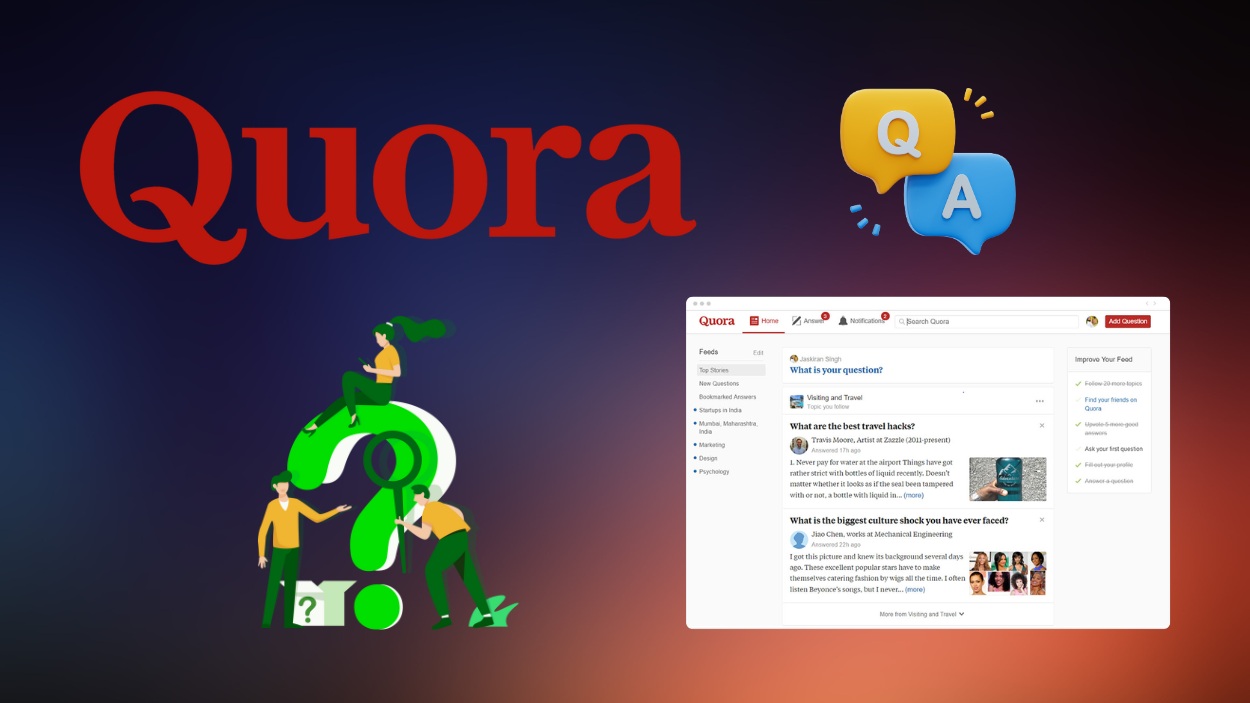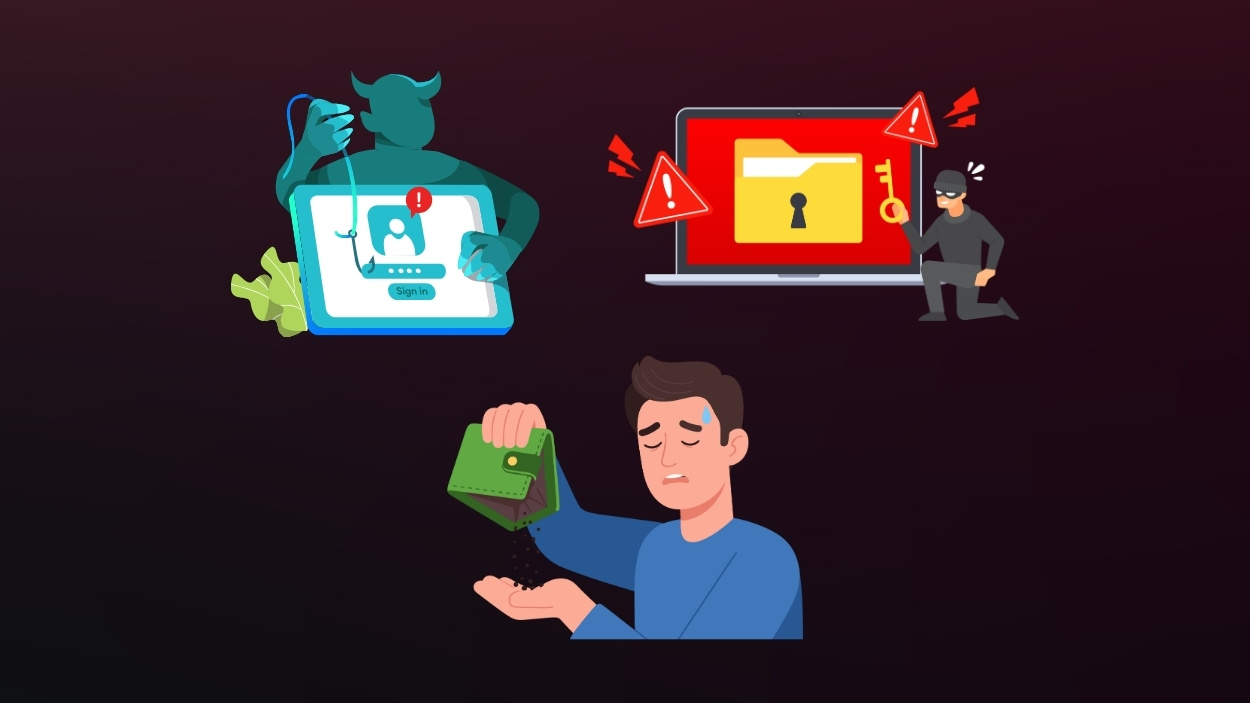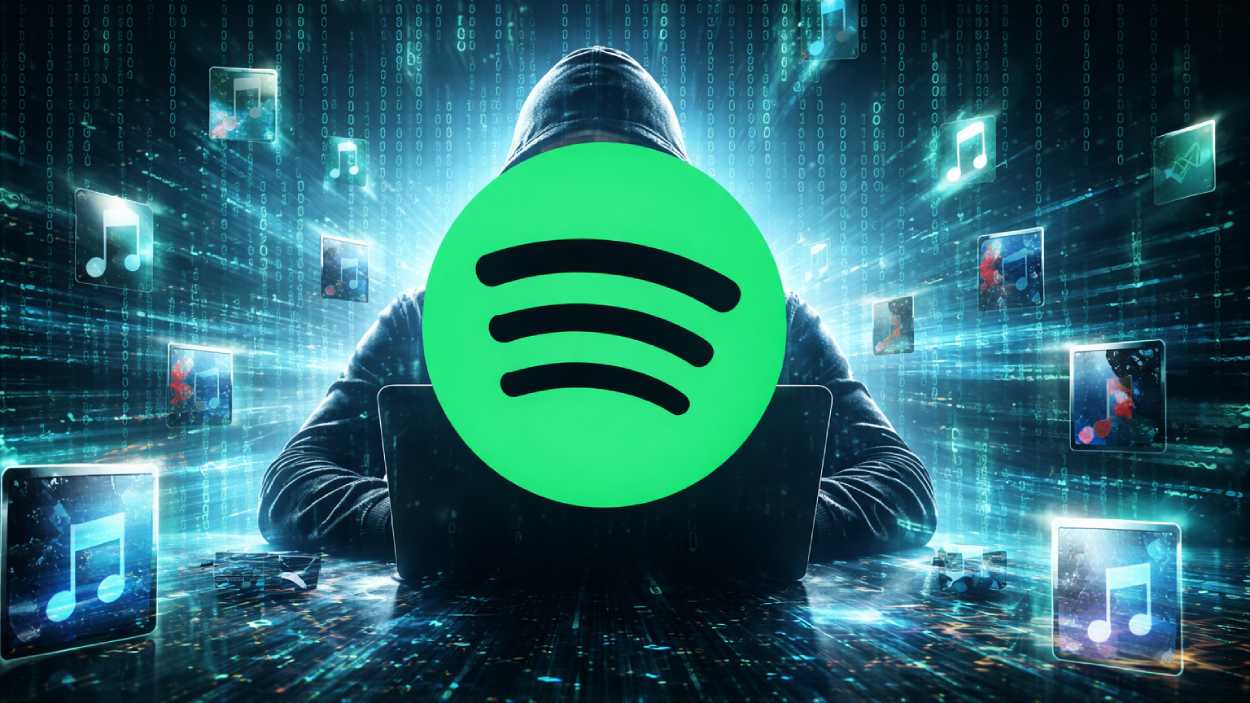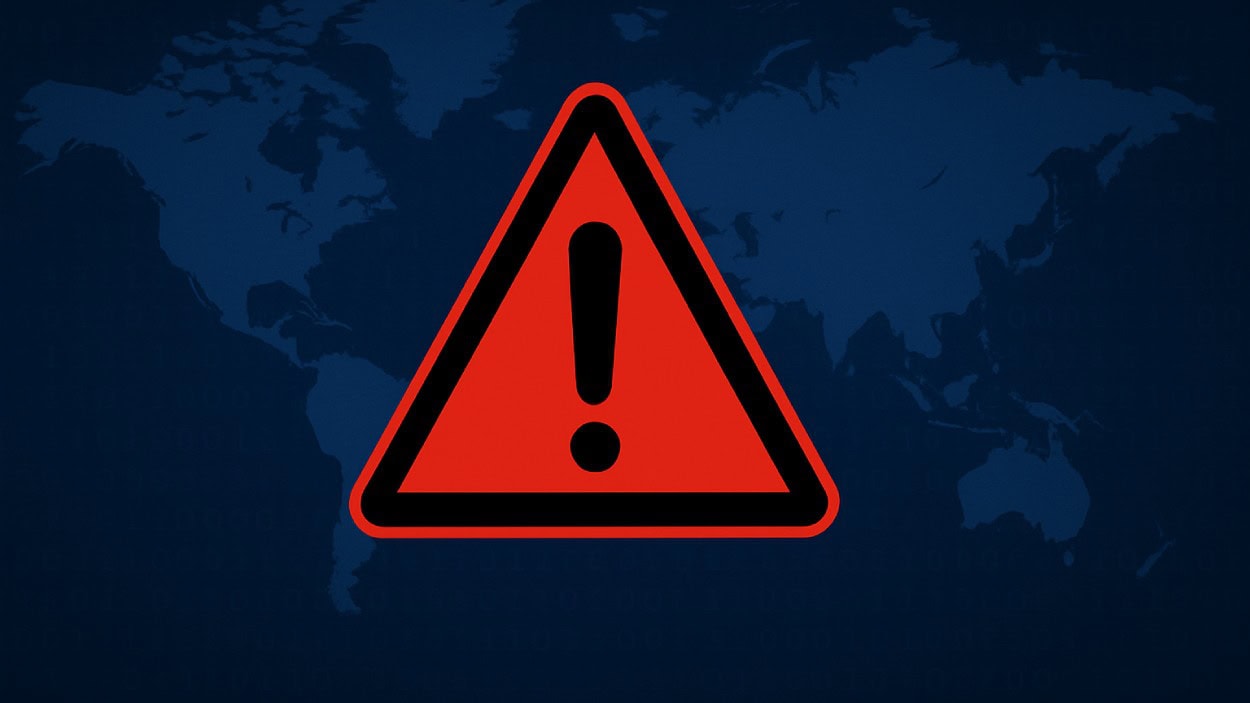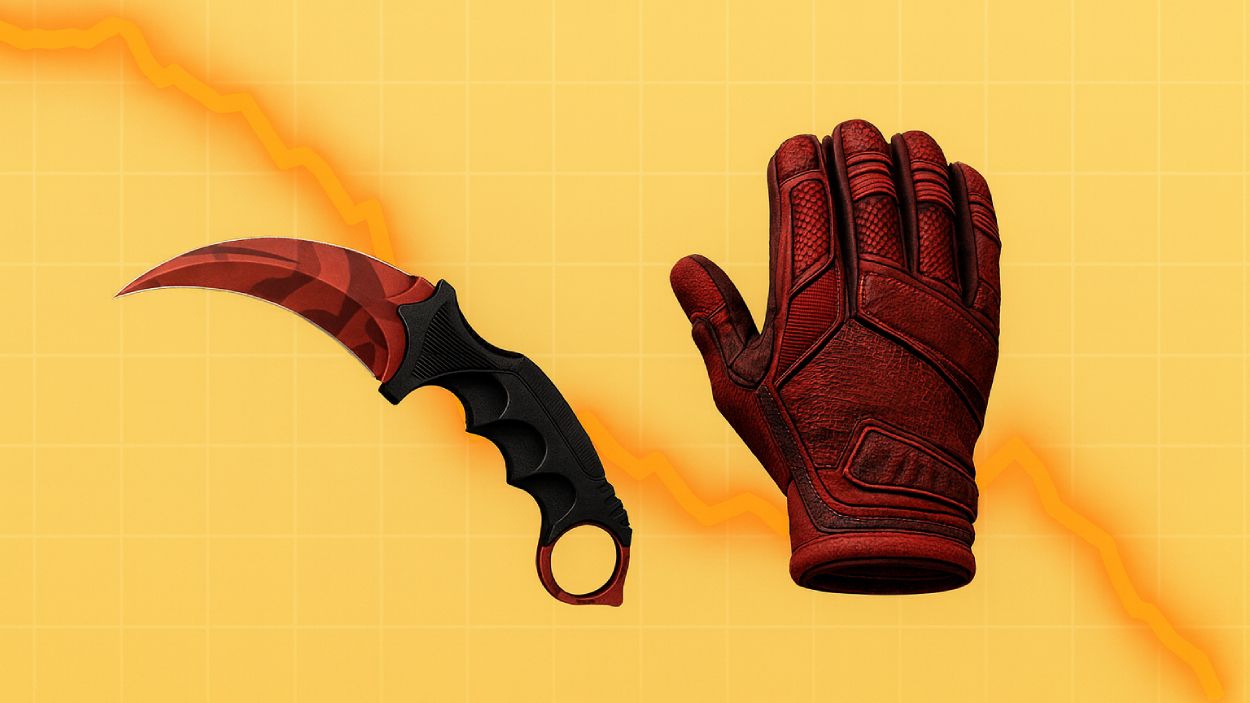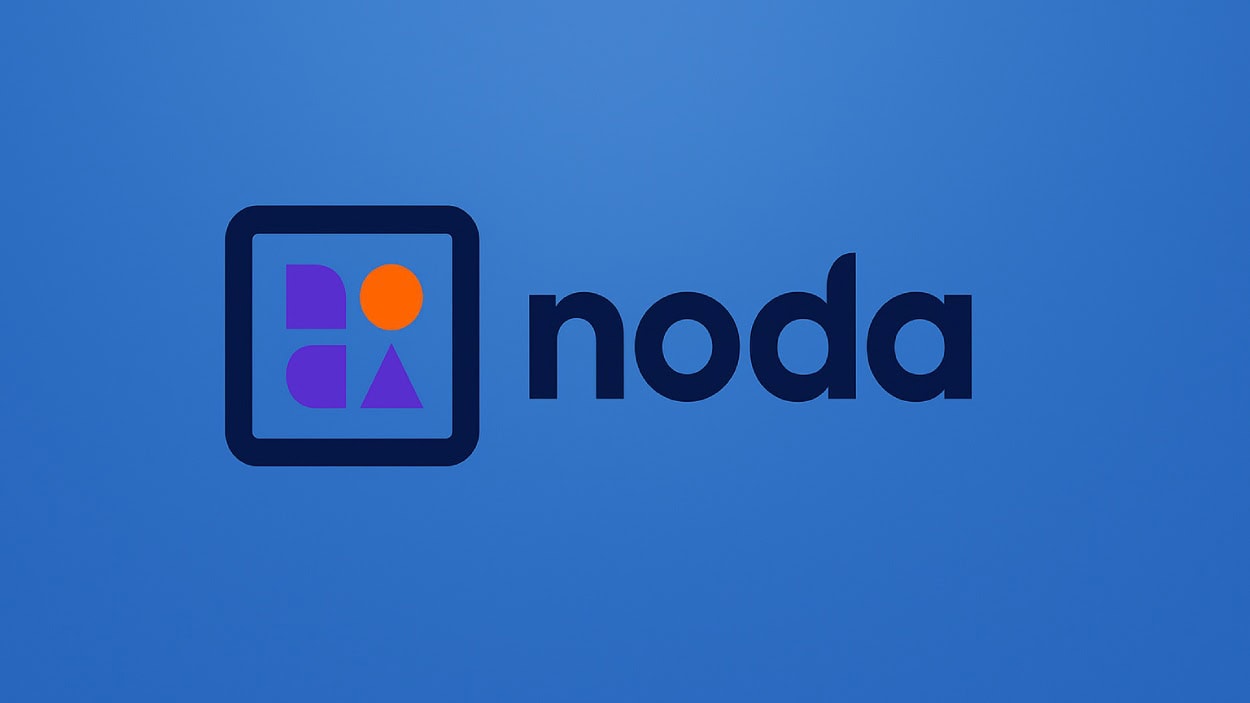It started as a playful comment under a photo. Then another one followed, meaner this time, sharper. Before she knew it, Ava, a 14-year-old high schooler in Ohio, found herself the target of a spiraling wave of online hate. Her story isn’t unique. In today’s hyperconnected world, social media platforms have become breeding grounds for bullying, where anonymity shields aggressors and algorithms sometimes amplify abuse.
As we move through 2025, cyberbullying isn’t just a digital nuisance, it’s a public health issue, a legal concern, and a psychological threat to millions. This article explores the hard numbers behind social media bullying, revealing who’s affected, where it’s happening, and what the data tells us about the digital world’s darker corners.
Editor’s Choice
- 67% of teenagers in the U.S. have experienced some form of cyberbullying on social media platforms in 2025.
- Instagram, Snapchat, and TikTok are the top three platforms where youth report the highest levels of harassment.
- Reports of body shaming incidents have surged by 35% on TikTok compared to 2024.
- 1 in 4 U.S. high school students say they’ve received direct threats via social media messaging apps.
- Only 38% of social media bullying victims in 2025 reported the abuse to a trusted adult or authority.
- Female-identifying teens are 1.8x more likely to experience harassment rooted in appearance-based comments than their male peers.
- According to CDC-linked data, 12% of teens who were cyberbullied in 2024–2025 had suicidal thoughts related to the experience.
Cyberbullying Trends and Teen Behavior Statistics
- 95% of teens actively use the internet and social media, creating a broad exposure to both the benefits and risks of digital interaction.
- 73% of school students say they have been bullied at some point in their lifetime, revealing the long-standing scope of the issue.
- 44% of students believe they were bullied within the last 30 days, showing how recent and ongoing these incidents are.
- 36.5% of people report being cyberbullied at some point in their lives, indicating the digital shift in bullying behaviors.
- 60% of teens have experienced some form of cyberbullying, making it a major concern among adolescent internet users.
- 70% of teens say someone has spread rumors about them online, showing how common online defamation is.
- 87% of young people have witnessed cyberbullying, highlighting its visibility and the passive role many teens find themselves in.

Global Prevalence of Social Media Bullying
- As of early 2025, 1 in 3 internet users worldwide has experienced social media bullying, according to GlobalWebIndex.
- In the U.S., 72% of middle and high school students have witnessed cyberbullying among peers online.
- The UK reported a 28% rise in teen-targeted harassment on social platforms compared to the previous year.
- In India, nearly 45% of teenagers say they’ve been harassed online, often by anonymous users.
- Brazil has seen a 40% year-over-year increase in reports of group-based bullying on WhatsApp and Instagram.
- A study from Australia’s eSafety Commission revealed that 62% of children aged 12–17 have encountered hate speech on social platforms.
- Canada reports that 56% of parents believe their children have been victims of cyberbullying, though only 21% of kids confirm discussing it with them.
- The Philippines ranks among the highest globally, with 78% of youth experiencing some form of social media bullying by age 18.
- In South Korea, gaming-based social platforms triggered a 19% spike in cyberbullying reports in early 2025.
- A 2025 UNESCO report notes that cyberbullying rates in low-income countries are rising faster than in developed nations, up 60% since 2022.
Age Groups Most Affected by Online Bullying
- The 13–17 age group continues to be the most targeted demographic, with 83% reporting at least one bullying incident online.
- Children aged 10–12 are increasingly vulnerable, with a 42% increase in bullying reports from 2024.
- Among users aged 18–24, 65% have experienced harassment tied to political or ideological views.
- Pre-teens (8–12 years old) using platforms like YouTube Kids or Discord report 32% higher emotional distress due to peer cyberbullying.
- College students aged 19–22 often face subtler but sustained forms of online shaming, with 58% noting incidents involving exclusion or rumors.
- Adults aged 25–34, while not primary targets, report growing workplace-related harassment on LinkedIn and Facebook, up 21% from 2023.
- A survey by Pew Research found that Generation Z (ages 10–26) is 2x more likely than Millennials to block, mute, or report cyberbullies.
- In 2025, teen girls aged 14–16 showed the highest rate of reporting body-based bullying, with 72% citing appearance-focused comments as the most common.
- Teens who spend over 5 hours per day on social media are 73% more likely to be victims of cyberbullying compared to those under 1 hour.
- Middle school students have shown a 30% increase in school-reported cyberbullying incidents since 2022.
Cyberbullying by Social Media Platform
- Twitter had the lowest reported share but still accounted for 9% of cyberbullying incidents.
- Instagram tops the list, with 42% of users identifying it as the platform where they experienced the most cyberbullying.
- Facebook follows closely, accounting for 37% of reported cyberbullying incidents among social media platforms.
- 31% of users said they experienced cyberbullying on Snapchat, making it the third most affected platform.
- WhatsApp was linked to 12% of cyberbullying cases, showing that private messaging apps aren’t exempt from online abuse.
- YouTube, despite being video-focused, had 10% of users report cyberbullying experiences.
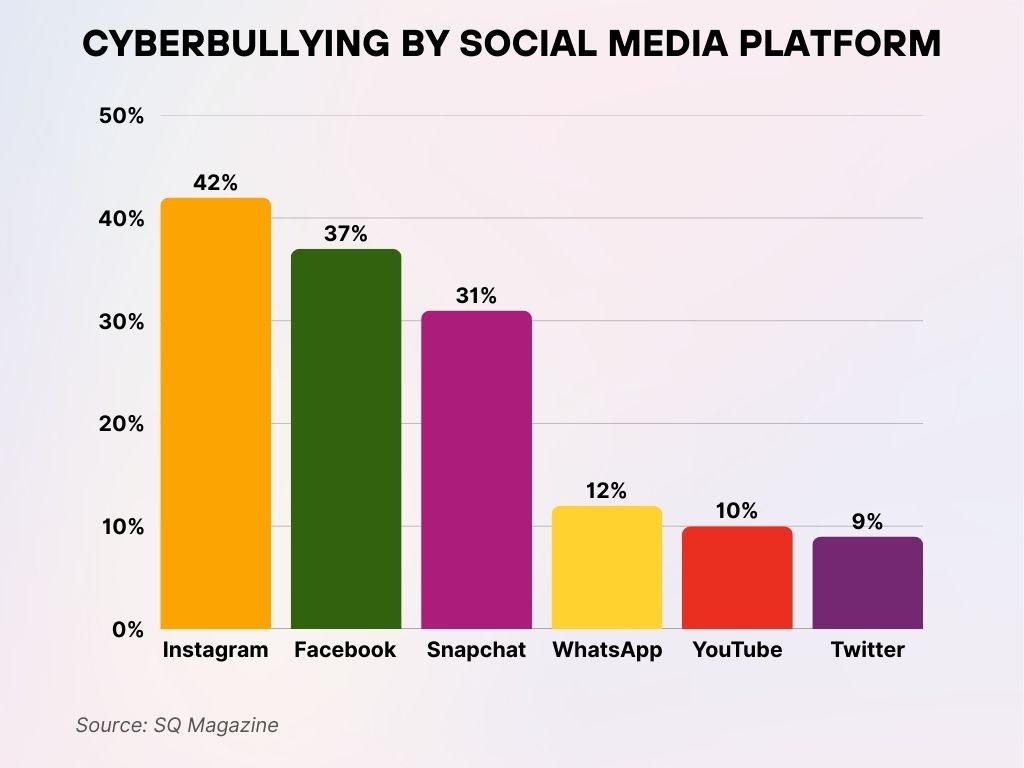
Psychological and Emotional Impact of Social Media Bullying
- In 2025, 39% of teens experiencing online bullying report moderate to severe anxiety symptoms.
- A CDC-backed mental health study found that 1 in 5 bullied teens exhibited signs of clinical depression.
- Female-identifying students are 2.3x more likely than males to report self-esteem issues after being targeted online.
- Among bullied teens, 12% have considered self-harm in the past year, and 6% have attempted it.
- High school counselors report a 50% increase in cases involving social media-related stress over the past 18 months.
- Students bullied online are 3.1x more likely to skip school or avoid digital learning platforms.
- Parental reports indicate that 61% of cyberbullied children show signs of social withdrawal or isolation.
- Sleep disruptions affect 44% of cyberbullying victims, as bullying often occurs late at night.
- Teens who experience cyberbullying are 4x more likely to develop disordered eating behaviors, according to a study by the National Eating Disorders Association.
- A 2025 survey by Mental Health America revealed that digital bullying victims were 68% more likely to use coping apps or therapy platforms like BetterHelp.
Gender Differences in Social Media Bullying Statistics
- In 2025, 71% of girls aged 13–17 report experiencing cyberbullying, compared to 54% of boys in the same age group.
- Girls are more likely to be targeted with appearance-based and exclusionary bullying, while boys face more aggressive or threat-based messages.
- Nonbinary and gender-diverse teens report the highest rate of social media bullying, with 76% experiencing repeated online harassment.
- A report from the University of Michigan states that social media bullying against girls tends to peak between ages 14 and 16, while for boys, it peaks at 13 to 15.
- Boys are more likely to dismiss or not report cyberbullying, with only 29% telling a parent or teacher, compared to 54% of girls.
- The use of deepfakes and AI-edited content has disproportionately affected girls, with 31% reporting their image was altered or misused online.
- Female teens involved in sports or public extracurricular activities are 2x more likely to receive negative commentary on appearance or performance.
- Male teens, on the other hand, report being targeted more frequently for skill-based insults in gaming communities and competitive spaces.
- Transgender students are over 3x more likely to be bullied on platforms like Instagram and TikTok than their cisgender peers.
- In 2025, gender-specific insults made up 47% of the most common keywords flagged by AI content moderation on major platforms.
Top Reasons Why People Are Cyberbullied
- 21.9% were targeted due to their physical appearance, showing that visual judgment remains a significant trigger for cyber abuse.
- 36.1% of individuals reported being cyberbullied over issues related to their dating partners, making it the most common reason.
- 31% faced online harassment due to their friendships, indicating how social circles can become targets of digital conflict.
- 31% were cyberbullied based on their sexual behavior, highlighting a serious area of privacy violation and judgment.
- 26.4% experienced cyberbullying because of their weight, reflecting ongoing issues with body shaming online.
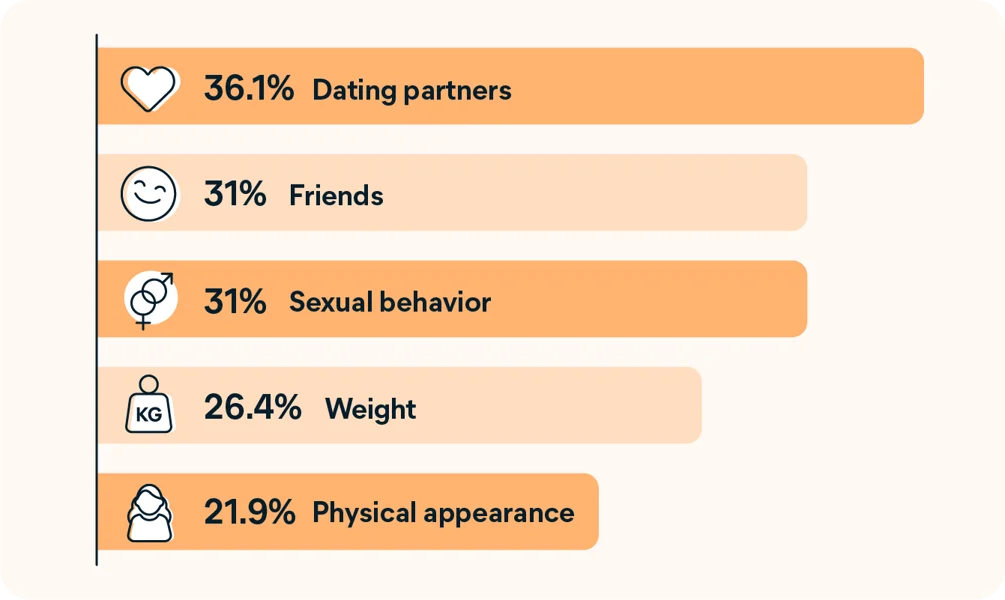
Ethnicity and Cyberbullying Among U.S. Teens
- Black and Hispanic teens report higher rates of race-based bullying, with 43% saying they’ve received slurs or derogatory comments online.
- Among Asian American students, 28% reported being targeted by COVID-related harassment, even years after the pandemic’s peak.
- White teens are the least likely to experience race-based cyberbullying but still face general social exclusion, with 41% affected.
- Native American teens show the highest underreporting rate, with only 18% sharing incidents with parents or school staff.
- A 2025 Pew Research Center report found that 61% of multiracial teens experienced bullying related to identity confusion or stereotyping.
- Ethnic-based meme culture on platforms like Reddit and TikTok has contributed to a 35% rise in subtle forms of racial mockery.
- Latino teens frequently report harassment around language, especially if they post in Spanish, 22% have been told to “speak English” online.
- Among Black youth, 59% say they’ve encountered racially charged comments while gaming or livestreaming.
- Studies show that algorithmic bias in moderation tools causes 40% more false flags on African American vernacular English (AAVE) than on standard language.
- Cultural organizations report that community-led anti-bullying initiatives in schools with diverse populations reduced incidents by 18% in 2024–2025.
Cyberbullying Among LGBTQ+ Teens in the U.S.
- In 2025, over 73% of LGBTQ+ teens report experiencing online harassment due to their identity.
- Transgender youth are 4.5x more likely to be targeted compared to cisgender peers.
- A GLSEN survey found that 1 in 3 LGBTQ+ students were bullied on multiple platforms within a single month.
- Misgendering remains a top cause of distress online, with 62% of trans youth citing it as their most frequent form of bullying.
- Deadnaming (using a person’s former name) was reported by 48% of LGBTQ+ teens as a repeated form of harassment.
- TikTok and Instagram are the platforms with the highest LGBTQ+ harassment reports, especially via comments and direct messages.
- Nonbinary teens face unique cyberbullying, often being mocked with gender-neutral pronouns or excluded in gendered discussions.
- Online hate groups targeting LGBTQ+ communities increased by 27% between 2023 and 2025, particularly on fringe platforms and anonymous message boards.
- Supportive content creators have helped combat the trend: 2025 saw a 14% rise in LGBTQ+ youth engagement with digital therapy and peer support pages.
- Despite this, only 36% of LGBTQ+ teens who are bullied online choose to report it to platform moderators, citing fear of inaction.
Where Adults Are Most Likely to Be Cyberbullied
- 10% were cyberbullied on online dating platforms, where personal vulnerability can be exploited.
- 75% of adults reported being cyberbullied on social media, making it the most common platform for online harassment.
- 41% said they experienced cyberbullying across multiple locations, showing how harassment can spread across digital spaces.
- 25% were targeted on forums or discussion sites, indicating that even niche online communities are not free from abuse.
- 24% of adults experienced cyberbullying through texting or messaging apps, reflecting how private conversations can turn hostile.
- 16% encountered cyberbullying in online gaming, showing how toxic behavior extends into virtual entertainment spaces.
- 11% said their personal email accounts were used to bully or harass them, underlining the reach of cyber aggressors.

Geographic Trends and Country-Specific Data
- The United States, India, and Brazil are the top three countries reporting the highest volume of social media bullying cases in 2025.
- In the UK, 32% of teens experience bullying centered around class or accent.
- Japan has seen a 19% spike in online bullying related to academic pressure and school rankings.
- Germany’s “Cyber Civil Courage” campaign led to a 21% drop in reported bullying cases in 2024–2025.
- In Canada, Quebec reports the lowest cyberbullying rate among provinces, while Ontario leads in teen incidents.
- South Africa has seen a rise in cyberbullying due to increased mobile adoption among youth, bullying reports have risen 44% since 2023.
- Australia’s online safety regulator fined two major platforms for failing to remove content promptly, highlighting increased national intervention.
- In France, anonymous harassment in school forums led to a national investigation after a teen suicide case linked to social media.
- Nigeria reports a 58% increase in Instagram-based bullying in urban youth, mostly driven by influencer culture.
- In Russia, a shift toward domestic platforms like VK has sparked concerns about limited moderation policies and increased tolerance of hate speech.
Role of Anonymity and Fake Accounts in Online Harassment
- In 2025, 68% of cyberbullying victims report being targeted by users with anonymous or fake profiles.
- Platforms that allow temporary usernames or unverified accounts, like Discord and X, have seen a 41% rise in harassment cases.
- Snapchat’s anonymous Q&A add-ons, such as YOLO or Sendit, are linked to 30% of teen bullying cases reported in schools.
- Meta reports that 17% of all bullying complaints in 2025 involved accounts created within the past 48 hours.
- AI-generated profile photos used for fake accounts increased by 220% between 2023 and 2025, complicating moderation.
- A joint study by Stanford and MIT revealed that users are 3.6x more likely to post hostile or inflammatory comments when using anonymous accounts.
- Teen bullies using multiple fake profiles for coordinated attacks (known as “dogpiling”) increased by 33% since 2024.
- Private or encrypted chat groups, such as WhatsApp and Telegram, are now responsible for 23% of cyberbullying reports among middle schoolers.
- Auto-ban systems based on IP flagging have decreased anonymity abuse by 12%, yet many bypass this using VPNs and secondary emails.
- A 2025 analysis by NortonLifeLock found that 1 in 9 fake accounts used for bullying was linked to an existing user via digital fingerprinting.
Countries with the Highest Risk of Experiencing Cyberbullying
- Italy, South Korea, Spain, and France report the lowest levels of cyberbullying risk among the countries listed.
- South Africa leads globally, with the highest risk of cyberbullying among internet users.
- India ranks second, showing a very high exposure rate to online harassment across its large digital population.
- United States holds the third spot, reflecting a consistently high-risk environment for online abuse.
- Australia and Canada follow closely, both facing significant levels of cyberbullying among their online communities.
- Denmark and the UK also show elevated risk, indicating that even developed digital nations are not immune.
- Countries like Singapore, Mexico, and Germany experience moderate risk levels of cyberbullying.
- Czechia, Colombia, and Brazil round out the middle of the chart, showing noticeable concern but lower compared to the top-tier countries.
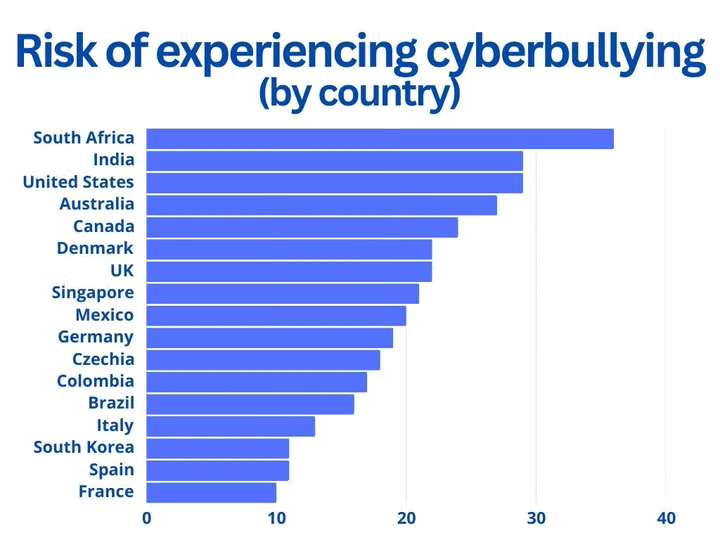
Reporting Rates and User Responses to Bullying
- Despite increased awareness, only 42% of social media bullying victims reported incidents to platforms in 2025.
- Of those who reported, just 27% said the platform took meaningful action, such as banning or warning the aggressor.
- Teens aged 13–15 are the least likely to report cyberbullying, only 31% take action, citing fear of retaliation or not being believed.
- Auto-moderation tools now catch 54% of abusive content before it reaches victims, up from 43% in 2023.
- 67% of bullied users attempt to block the offender rather than report them, making platform intervention difficult.
- Among LGBTQ+ users, only 1 in 3 reports harassment, citing platform inaction or repeated offense as reasons.
- A study by Common Sense Media revealed that when a friend intervenes online, victims are 2.5x more likely to feel supported and less emotionally affected.
- Schools with digital peer support programs saw a 28% reduction in unreported bullying compared to schools without such initiatives.
- Instagram’s AI-driven “comment nudging” feature, which warns users before posting something harmful, helped reduce repeat harassment by 17%.
- Platform-specific report satisfaction ranked highest for TikTok (42% satisfaction), followed by Instagram (38%) and X (28%).
Institutional and Parental Responses to Social Media Bullying
- In 2025, 49% of U.S. schools have implemented formal anti-cyberbullying digital literacy programs.
- Schools that integrate social media conflict resolution into health classes report a 33% drop in bullying referrals.
- Only 37% of parents regularly monitor their children’s social media use, despite 78% claiming concern about online bullying.
- Parental control apps like Bark and Qustodio have seen a 19% growth in usage among families with teens.
- Teachers report that cyberbullying incidents now account for 1 in 5 behavioral cases they manage weekly.
- School-based therapists say over half their caseload involves stressors from online interactions, up 12% from 2024.
- PTA-led community workshops have been shown to improve parent intervention confidence by 40%.
- State-funded grants for anti-bullying curricula were available in 38 states in 2025, a rise from 26 in 2023.
- Surveys show students are more likely to report cyberbullying to school counselors than to platform moderators or parents.
- The “Digital Wellness Pledge”, adopted by 2,100 schools nationwide, encourages students to act as online upstanders, not bystanders.
Most Common Cyberbullying Threats
- Another 12% reported sustained harassment, highlighting the ongoing nature of some cyberbullying experiences.
- 41% of cyberbullying cases involve general harassment, making it the most reported online abuse threat.
- 35% of victims experience offensive name-calling, reflecting the widespread use of hurtful language in digital interactions.
- 27% reported facing severe harassment, which includes more intense or repeated forms of online abuse.
- 26% of individuals were subjected to purposeful embarrassment, often through public shaming or exposure.
- 18% received physical threats online, indicating that digital abuse can escalate into real-world danger.
- 13% experienced stalking, involving persistent and unwanted online attention.
- 12% faced sexual harassment, showcasing the vulnerability many face in digital spaces.
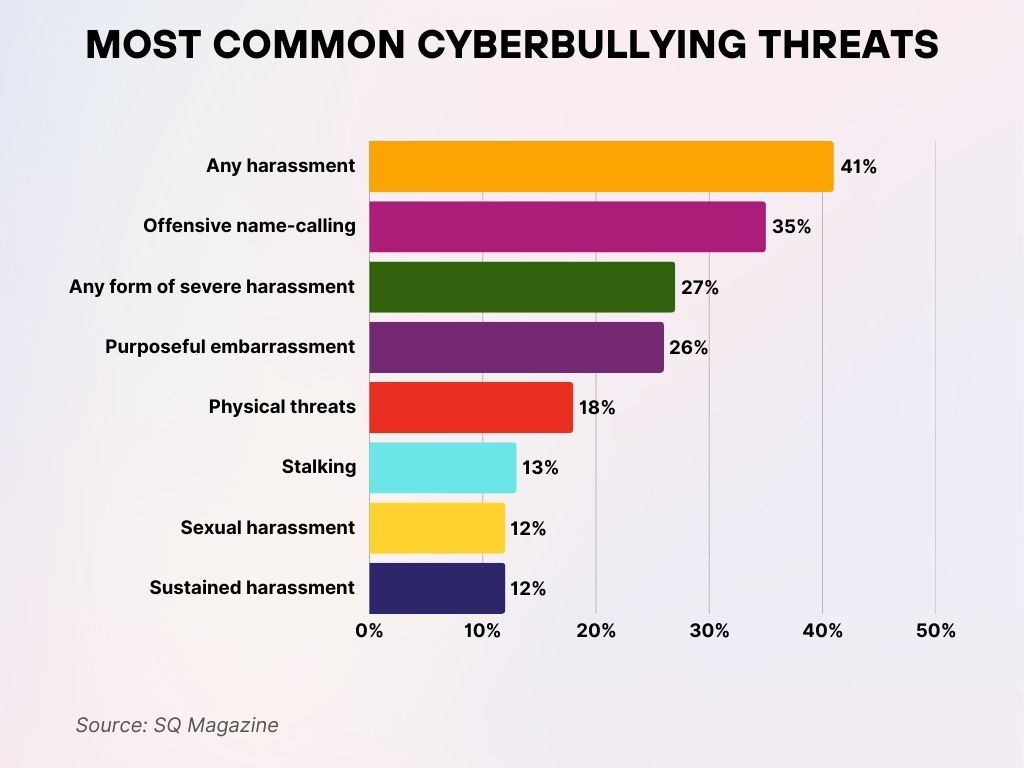
Legal Framework and Anti-Cyberbullying Policies
- In 2025, 12 U.S. states have passed updated digital harassment laws, including penalties for repeated online abuse.
- California’s Cyber Harassment Prevention Act now allows victims to request court-ordered account takedowns across platforms.
- Federal legislation proposals, such as the Kids Online Safety Act, aim to hold platforms accountable for algorithmic amplification of hate.
- The EU’s Digital Services Act mandates the removal of harmful content within 24 hours, affecting global platforms like Meta and TikTok.
- Australia’s eSafety Commissioner issued over 300 content takedown notices in 2025 alone, a 72% increase from last year.
- The UK’s Online Safety Bill enables fines up to £18 million or 10% of global turnover for platforms failing to protect users.
- Canada passed legislation making it illegal to use AI-generated images or videos to defame or harass, with up to 5 years in prison.
- In the U.S., 42% of parents support stricter legal punishments for teen cyberbullies, even if they are minors.
- Global watchdog groups, like CyberSafeKids and Amnesty Tech, are lobbying for transparency in the algorithm bias used in moderation.
- Lawsuits against social media platforms for enabling cyberbullying increased by 24% in 2024–2025, primarily involving minors.
Recent Developments in Social Media Bullying Statistics
- TikTok introduced AI-driven sentiment detection tools in Q1 2025, leading to a 21% decrease in toxic comments.
- Meta launched “Protect Teens Mode”, which restricts interaction from unfamiliar users under age 18, used by 3.5 million accounts already.
- Teen suicide prevention groups saw a 17% spike in engagement on platforms offering peer-to-peer support like Reddit and Snapchat.
- AI voice cloning harassment cases are emerging, reported by 11% of U.S. high schoolers, especially in voice chat apps.
- Real-time bullying detection features in video gaming communities now flag an average of 9,700 abuse cases daily, according to Xbox Trust & Safety.
- Google’s YouTube Kids added new layered filters in early 2025 to block derogatory language, reducing reported incidents by 30%.
- Schools are now piloting VR empathy simulations to help students understand the effects of online bullying firsthand.
- Cyberbullying awareness hashtags on Instagram and TikTok, like #StopOnlineHate and #BeKind2025, have gained over 1 billion views this year.
- WhatsApp’s partnership with NGOs has led to the rollout of in-chat support bots for bullying victims in over 20 countries.
- In early 2025, Amazon’s Twitch banned over 15,000 accounts for coordinated bullying behaviors, signaling stricter enforcement across content platforms.
Conclusion
As social media becomes more woven into the fabric of our daily lives, the challenge of cyberbullying grows more complex. While technology is partly to blame, it also offers solutions, from AI moderation to digital literacy tools and community support.
The data paints a clear picture: bullying is evolving, and so must our response. Education, enforcement, empathy, and empowerment must be at the center of every strategy. For teens like Ava, and millions like her, a safer digital future is not just an option, it’s a necessity.










